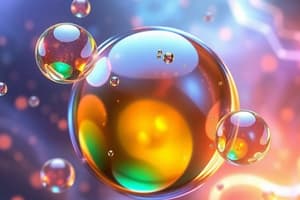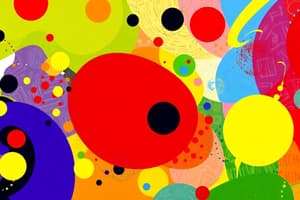Podcast
Questions and Answers
What fundamental change at the atomic level leads to the formation of an ion?
What fundamental change at the atomic level leads to the formation of an ion?
- Change in the number of molecules.
- Change in the number of neutrons.
- Gain or loss of electrons. (correct)
- Change in the number of protons.
In forming a stable ionic compound between a metal and a nonmetal, what drives the metal atom to become a cation?
In forming a stable ionic compound between a metal and a nonmetal, what drives the metal atom to become a cation?
- To decrease its nuclear charge.
- To increase its atomic mass.
- To increase its electronegativity.
- To achieve a full outer electron shell, resembling a noble gas configuration. (correct)
How does the concept of a 'stable octet' influence the chemical behavior of atoms?
How does the concept of a 'stable octet' influence the chemical behavior of atoms?
- Atoms only interact if they already possess eight valence electrons.
- Atoms always prefer to have exactly eight protons in their nucleus.
- Atoms tend to gain, lose, or share electrons to achieve an electron configuration similar to noble gases. (correct)
- Atoms aim to have eight neutrons in their nucleus for stability.
What is the key distinction between a binary and a ternary compound?
What is the key distinction between a binary and a ternary compound?
Under what conditions would an ionic bond most likely form?
Under what conditions would an ionic bond most likely form?
In a chemical equation, what information is conveyed by the coefficients?
In a chemical equation, what information is conveyed by the coefficients?
What is the fundamental difference in electron behavior between an ionic and a covalent bond?
What is the fundamental difference in electron behavior between an ionic and a covalent bond?
How is the combining capacity of an element related to its valence electrons?
How is the combining capacity of an element related to its valence electrons?
What role does ionization play in the context of acids and bases?
What role does ionization play in the context of acids and bases?
What occurs at the molecular level during the process of neutralization?
What occurs at the molecular level during the process of neutralization?
How would you classify $NH_4Cl$?
How would you classify $NH_4Cl$?
What is the significance of the pH scale in assessing the properties of a solution?
What is the significance of the pH scale in assessing the properties of a solution?
Which of the following is an example of a polyatomic ion?
Which of the following is an example of a polyatomic ion?
Given the chemical equation $2H_2 + O_2 \rightarrow 2H_2O$, what does the coefficient '2' in front of $H_2O$ represent?
Given the chemical equation $2H_2 + O_2 \rightarrow 2H_2O$, what does the coefficient '2' in front of $H_2O$ represent?
In a chemical reaction, how do reactants differ from products?
In a chemical reaction, how do reactants differ from products?
If a substance donates protons ($H^+$) when dissolved in water, how is it classified?
If a substance donates protons ($H^+$) when dissolved in water, how is it classified?
What is the primary factor that determines whether a compound is classified as organic or inorganic?
What is the primary factor that determines whether a compound is classified as organic or inorganic?
What distinguishes a molecule from an ion, at a fundamental level?
What distinguishes a molecule from an ion, at a fundamental level?
Consider the reaction: $HCl + NaOH \rightarrow NaCl + H_2O$. Which compounds are classified as salt?
Consider the reaction: $HCl + NaOH \rightarrow NaCl + H_2O$. Which compounds are classified as salt?
How does dissociation differ from a typical chemical reaction?
How does dissociation differ from a typical chemical reaction?
Flashcards
Ion
Ion
An atom or molecule with a net electric charge due to the loss or gain of electrons.
Cation
Cation
A positively charged ion formed when an atom loses electrons.
Anion
Anion
A negatively charged ion formed when an atom gains electrons.
Ionic charge
Ionic charge
Signup and view all the flashcards
Combining capacity
Combining capacity
Signup and view all the flashcards
Valence electron
Valence electron
Signup and view all the flashcards
Stable octet
Stable octet
Signup and view all the flashcards
Polyatomic ion
Polyatomic ion
Signup and view all the flashcards
Binary compound
Binary compound
Signup and view all the flashcards
Ternary compound
Ternary compound
Signup and view all the flashcards
Ionic bond
Ionic bond
Signup and view all the flashcards
Covalent bond
Covalent bond
Signup and view all the flashcards
Molecule
Molecule
Signup and view all the flashcards
Binary covalent compound
Binary covalent compound
Signup and view all the flashcards
Reactant
Reactant
Signup and view all the flashcards
Product
Product
Signup and view all the flashcards
Chemical equation
Chemical equation
Signup and view all the flashcards
Coefficient
Coefficient
Signup and view all the flashcards
Acid
Acid
Signup and view all the flashcards
Base
Base
Signup and view all the flashcards
Study Notes
1.1 – Plant and Animal Cells
Prokaryotes vs Eukaryotes:
Prokaryotes: No nucleus, simple structure, no membrane-bound organelles (e.g., bacteria).
Eukaryotes: Have a nucleus and membrane-bound organelles (e.g., plant and animal cells).
Organelles – Structures and Functions:
Animal & Plant Cells:
• Cell Membrane: Controls what enters and leaves the cell; provides protection.
• Cytoplasm: Jelly-like substance where cell organelles are suspended.
• Cytoskeleton: Provides structure and shape; aids in movement within the cell.
• Nucleus: Contains DNA; controls cell functions.
• Chromatin: Uncondensed DNA; found during interphase.
• Chromatids: Each of the two identical halves of a replicated chromosome.
• Chromosomes: Condensed DNA visible during mitosis; carries genetic info.
• Ribosomes: Site of protein synthesis.
• Endoplasmic Reticulum (ER):
• Rough ER – has ribosomes; protein synthesis.
• Smooth ER – no ribosomes; lipid synthesis.
• Golgi Apparatus: Modifies, sorts, and packages proteins/lipids for transport.
• Centrioles: Help in cell division (spindle formation).
• Mitochondria: “Powerhouse”; site of cellular respiration, produces ATP.
Animal Only:
• Lysosomes: Contain enzymes to break down waste and cellular debris.
Plant Only:
• Chloroplasts: Site of photosynthesis; contains chlorophyll.
• Vacuoles: Large central vacuole stores water and maintains turgor pressure.
• Cell Wall: Provides structure and protection; made of cellulose.
1.2 – The Cell Cycle & Mitosis
Phases of the Cell Cycle:
**Interphase**: Cell grows and prepares for division.
• G1: Cell grows and performs normal functions.
• S (Synthesis): DNA is replicated because the cell has grown to a point where it can't function properly..
• G2: Prepares for mitosis.
• G0: Resting phase; cell is not dividing.
**Mitosis**:
• Prophase: Chromatin condenses into chromosomes; nuclear envelope dissolves. chromosomes grow
• Metaphase: Chromosomes align at the metaphase plate. make a line in the middle
• Anaphase: Sister chromatids are pulled apart to opposite poles. pull apart to each side
• Telophase: Nuclear envelope re-forms; chromosomes de-condense. split to two circles
**Cytokinesis**:
• Animal Cells: Cell membrane pinches in and then pulls apart (cleavage furrow).
• Plant Cells: Cell plate forms to divide the cytoplasm.
Necrosis vs Apoptosis:
• Necrosis: Unplanned cell death due to injury or damage.
• Apoptosis: Programmed cell death; natural and controlled.
Asexual vs Sexual Reproduction:
• Asexual: One parent; offspring are genetically identical (e.g., mitosis).
• Sexual: Two parents; offspring are genetically diverse.
1.3 – Specialized Cells
Regeneration:
• The ability to regrow damaged or missing body parts (e.g., starfish, lizards).
Stem Cells:
• Undifferentiated cells that can become various types of specialized cells.
Animal Tissues – Function and Examples:
• Epithelial Tissue: Covers body surfaces and lines organs ( Ex: Skin, lining of digestive tract. )
• Connective Tissue: Supports, binds, and protects organs ( Ex : Blood, bone, cartilage, fat. )
3 Components of Blood:
• Red blood cells (carry oxygen),
• White blood cells (fight infection),
• Platelets (clotting).
**Muscle Tissue:**
• Enables movement.
• 3 Types: Skeletal (voluntary), Cardiac (heart), Smooth (organs).
**Nervous Tissue:**
• Sends and processes electrical signals.
• Made of neurons and supporting cells.
Plant Tissues – Function:
**Epidermal Tissue**:
• Outer protective layer.
• Stomate (Stomata): Pores for gas exchange.
**Ground Tissue:**
• Performs photosynthesis and stores nutrients.
**Photosynthesis**:
• Reactants: CO₂ + H₂O + sunlight
• Products: Glucose (C₆H₁₂O₆) + O₂
**Vascular Tissue**:
• Transports substances.
• Xylem: Carries water and minerals from roots to leaves.
• Phloem: Carries sugars from leaves to the rest of the plant.
**Meristematic Tissue:**
• Responsible for plant growth; contains actively dividing cells.
Studying That Suits You
Use AI to generate personalized quizzes and flashcards to suit your learning preferences.




